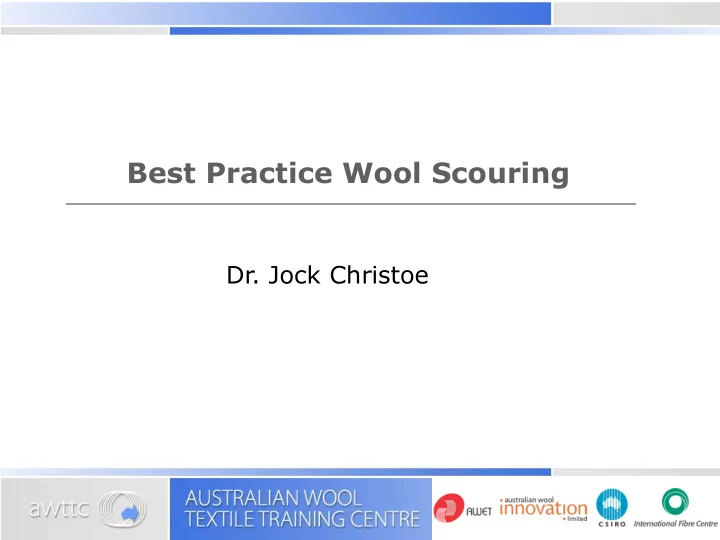

Best Practice Wool Scouring Dr. Jock Christoe
Best Practice - Definition Make a profit by producing a product in an environmentally sustainable way that is acceptable to the customer at the lowest possible cost
Factors Affecting Best Practice § Type of wool § Type of enterprise § Resource issues § Environmental issues
Type of Wool § Combing types § Carding types
Type of Enterprise § Commission scourer § Commission comber/topmaker § Vertical mill
Resource issues § Water § Energy § Chemicals § Labour § Spare parts
Environmental Issues § Discharges from scouring line § Environmental discharge regulations § Options for effluent treatment § Market Drivers
Layout of a Scouring Line Pre-scouring Scouring Post -scouring Contaminant Recovery Wastewater Treatment
Best Practice - Processing § Pre-Scouring Processes § Scouring process § Post-Scouring Processes § Contaminant Recovery
Best Practice – Pre-Scouring § Blend layout § Blending/Opening equipment § Extent of opening
A Typical Preparation Sequence
Best Practice – Scouring Process § Minimising entanglement § Scour configuration § Mechanical issues § Water § Detergent
Entanglement and Processing Performance § Definition § Causes § Reduction
Causes of Entanglement § Fibre characteristics § Opening § Mechanical effects § Scour configuration § Scouring conditions
Fundamental Issues in Felting of Wool § Scales are the major cause of felting § scale direction affects differential friction § fibre flexibility affects felting § water increases differential friction and flexibility
Practical Issues in the Felting of Wool § Felting requires both fibre movement and contact § felting is most efficient when fibres are wet § soap and lubricants increase felting § fibre disorientation promotes felting § felting increases with water temperature up to a point
Entanglement § Mechanical Elements § Preparation § Fibre movement in bowl § Length of bowls § Bowl Configuration § Operating Conditions
Entanglement The concept of working points
Working Points in a Typical Wool Scour 7.CONVEYOR 2. DUNKERS 5.WOOL 4.BOWL TRANSFER LEVEL 1. SPRAY BOX 6.SQUEEZE 3.RAKES false bottom
Opportunities for Entanglement in a Scour 1. Feed to a bowl
Opportunities for Entanglement in a Scour 2. Dunkers
Opportunities for Entanglement in a Scour 3. Transport Mechanisms
Opportunities for Entanglement in a Scour 4. Water Level
Opportunities for Entanglement in a Scour 5. Transfer from the Bowl
Opportunities for Entanglement in a Scour 6. Squeezing Rollers
Opportunities for Entanglement in a Scour 7. Wet Opening
Best Practice – Scouring Process Scour Configuration § Number of bowls § Length of bowls § Shape of bowls § Bowl function
Best Practice – Scouring Process Mechanical § Entanglement minimisation § Fibre cleansing § Production of an even mat through the scour
Best Practice – Scouring Process Water Aim § Minimise water consumption without comprimising product quality How § Water quality § Optimise recovery loops § No uncontrolled discharges § Split flows § Recycle rinsewater
Best Practice – Scouring Process Detergent § Type of detergent § Method of addition § Multiple bowl additions with countercurrent flow 20% 50% 30% B1 B1 B1
Best Practice – Post-Scouring § No wet openers § Even mat of scoured wool § Dryer performance
Best Practice – Contaminant Recovery Dirt Recovery § Bowl is for scouring not a dirt recovery device § Flow rates 5-10 KL/hour per bowl § Manifold system connecting to bowls
Best Practice – Contaminant Recovery Wool Wax Recovery § Three-stage recovery § Flow rates 1KL/hour per 100kg greasy wool § No discharge without passage through wax recovery
Best Practice – Wastewater Treatment § Integration with scouring line § Optimisation of contaminant recovery § Optimisation of water use § No uncontrolled discharges § Separation of waste streams
Summary
Recommend
More recommend